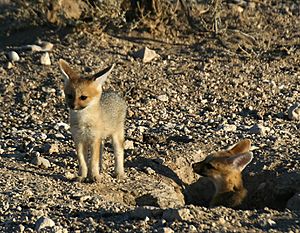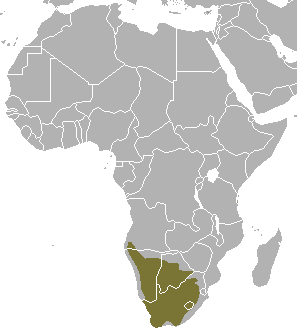Cape fox facts for kids
Quick facts for kids Cape fox |
|
|---|---|
 |
|
| Adult feeding on a helmeted guineafowl in Etosha National Park | |
 |
|
| Cape fox kits | |
| Conservation status | |
| Scientific classification | |
| Genus: |
Vulpes
|
| Species: |
chama
|
 |
|
| Cape fox range | |
| Synonyms | |
|
|
The Cape fox (Vulpes chama) is a small fox from southern Africa. People sometimes call it the asse or silver-backed fox. It's a bit like a fennec fox because it has big ears!
This fox has black or silver-gray fur. Its sides and belly are light yellow. The tip of its tail is always black.
A Cape fox is usually about 45 to 61 cm (18 to 24 in) long. Its tail adds another 30 to 40 cm (12 to 16 in). It stands 28 to 33 cm (11 to 13 in) tall at the shoulder. These foxes typically weigh between 3.6 to 5 kg (7.9 to 11.0 lb).
Contents
Where Do Cape Foxes Live?
Cape foxes mostly live in open areas. These can be grassy plains with some bushes or dry, scrubby deserts. They also live in a type of plant area called fynbos.
You can find them across Zimbabwe, Botswana, and South Africa. They live in many parts of the Western and Northern Cape provinces. They are also in the Eastern Cape, Free State, and parts of KwaZulu-Natal and North-West provinces. They even live in Lesotho, which is a high mountain region.
How Do Cape Foxes Behave?
Cape foxes are nocturnal. This means they are most active at night. You might spot them just before sunrise or after sunset. During the day, they hide in burrows underground. They also use holes, hollows, or thick bushes to rest.
These foxes are good at digging. They can dig their own burrows. But they often use and change old burrows made by other animals, like the springhare. Cape foxes are usually solitary animals. Even if they have a mate, the male and female often look for food alone.
They don't usually fight over their territory. But they do mark their areas with a strong scent. Cape foxes are mostly quiet. They make soft calls, whines, or chirps to talk. If they get scared, they will let out a loud bark. When they are angry, they might growl and spit. If a fox is excited, it lifts its tail. The higher the tail, the more excited it is!
What Do Cape Foxes Eat?
Cape foxes are omnivores. This means they eat both plants and animals. They like small animals like rodents and insects best. But they will eat almost anything they can find.
They hunt and eat reptiles, rabbits, spiders, and birds. They also eat young hares. Their diet includes eggs, beetle larvae, and dead animals. They also enjoy most insects and fruits. It's rare, but Cape foxes have been known to kill lambs up to three months old.
How Do Cape Foxes Have Babies?
Cape foxes can have babies all year round. This is different from some other foxes, like the red fox.
A female Cape fox is pregnant for about 51 to 53 days. She then gives birth to one to six cubs, also called kits. The cubs grow up underground in burrows. They stay close to their den until they are about four months old.
They stop drinking milk around six to eight weeks old. But they don't start looking for their own food until they are four months old. Cubs usually become independent at five months old. They then leave their family, often in June or July. Both parents take care of the young. The male even brings food to the female for the first two weeks.
A family group usually has the parents and their young. Sometimes, different family groups might meet while looking for food. A female can have more than one litter of cubs. But she usually chases away the older cubs when she is expecting new ones.
Cape foxes are fully grown in about a year. Both males and females can have their own babies when they are 9 months old.
A Cape fox usually lives for about six years. But some can live for up to 10 years.
Images for kids
See also
 In Spanish: Zorro del Cabo para niños
In Spanish: Zorro del Cabo para niños




